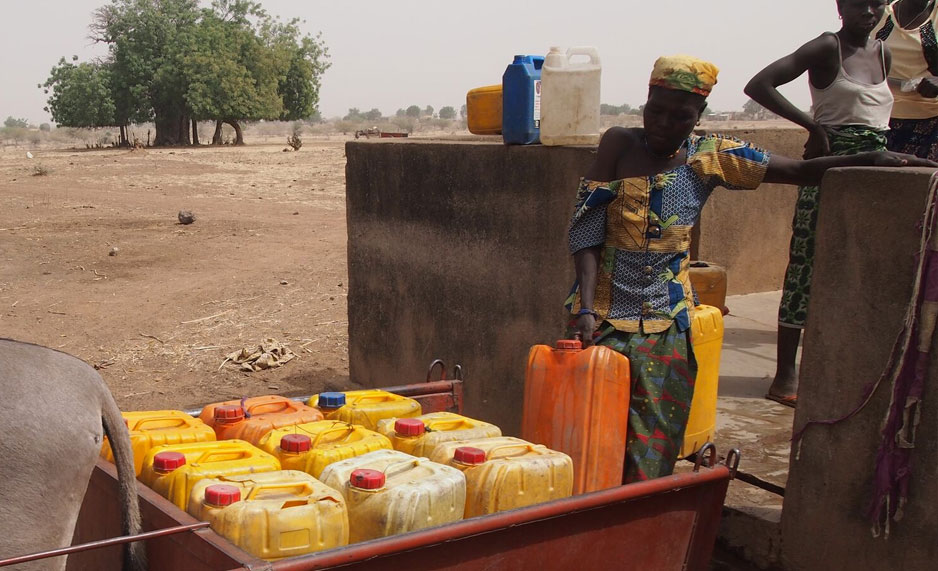Terms like “climate finance” and “decarbonization” may mean little to poor farmers in rural Burkina Faso, but the impacts of a volatile climate are all too familiar. When water runs out towards the end of the dry season, as it often does in parts of the country, scarce clean water supplies must be rationed between livestock, and drinking, cooking and laundry; small businesses and brick-making are put on hold. During the worst years, some people migrate to cities and neighbouring countries.
There is growing awareness at international level that water is central to climate adaptation, and that safe water and sanitation access are threatened by climate-related changes. Water issues are being included in National Adaptation Plans, and efforts are being made to ”climate-proof” water and sanitation infrastructure – for example by constructing simple rainfall monitoring stations to estimate how much water is available for use, installing rainwater-harvesting systems or reservoirs, or hand-digging deeper or more numerous wells.
But how far are these efforts guided by an understanding of differences in the roles and vulnerabilities of women and men, or of marginalized groups in society? And if they are not, isn’t there a high risk that they will simply reinforce existing inequalities?
Video: SEI / YouTube.
Thanks to a REACH Catalyst grant, last year we carried out research in the Centre-Est region of Burkina Faso, bordering Ghana and Togo. As part of the research, we spoke to smallholder farmers and local NGOs working on these issues, including Wateraid, DAKUPA and l’Association Chant de femme. We started to understand better how water insecurity affects women and men differently, which influences how they cope with the impacts.
As one example, we learned that paying family water user fees is considered a man’s responsibility, while fetching water is a woman’s. However, if cash is short, men will often take money women earn through small businesses like making shea butter. When water is scarce and has to be collected from an hour or more away, it would be socially unacceptable for men to help, even if it would benefit the family.
Another phenomenon we heard about again and again is water scarcity – and its impact on farming yields – pushing men to migrate to work in neighbouring countries, or even to Europe for seasonal farm labour. This leaves women with even more responsibility for the household water and sanitation needs as well as farming.
Women also told us about how they try to cope in the dry season, using strategies like getting up very early to collect water, making water reserves, prioritizing water uses in the household, and sometimes abandoning their side-businesses. However, the reality is that they are sometimes forced to rely on extremely unsafe water supplies, putting their own and the household’s health at risk.

A woman’s work? Women collecting water in rural Centre-Est, Burkina Faso. Photo: Sarah Dickin.
It’s clear that some of these coping strategies will not be enough in the long run, as climate projections indicate that dry spells will get longer and the rainy season will start later in the region. Small dams and water storage reservoirs were often suggested by both men and women as a way of providing more reliable water supplies. Organizations like Wateraid (who collaborated in the research) are working with communities to make water, sanitation and hygiene provision more climate-resilient.
Clearly infrastructure will be an important part of the solution. But our research highlighted the need for adaptation and development programmes to look at gender: not just at the differentiated roles and vulnerabilities in relation to water, but also at ensuring women have an equal voice in adaptation planning. This is important because although women deal with day-to-day water issues, community water committees are largely made up of men, and it is men who address local authorities.
Fundamentally, this will require challenging traditional expectations of men’s and women’s roles in these villages. This is not an easy thing to do, but it is needed – and climate change adaptation could provide a good entry point for men and women to start such a discussion.
Video: SEI / YouTube.
Local authorities and organizations like Wateraid can help this process by ensuring that women have a voice, and real influence, in their community water security and climate adaptation projects. This echoes priority areas outlined at a global level in the first-ever Gender Action Plan for gender-responsive climate action, which was launched at the COP23 climate meeting last November, including gender-responsive implementation, capacity building, and women’s leadership.
Of course, many such projects already aim to promote gender equality and empower women. But how far they succeed is hard to measure, and thus hard to say.
That’s why in the next part of our REACH study we will be developing an Index of Empowerment in water, sanitation and hygiene (WASH). The index will be a way to quantify men and women’s empowerment in relation to WASH. It will take into account decision-making, participation and control of resources, both inside and beyond the household.
We anticipate that the index will be useful in several ways. For example, it could help in the design of new adaptation projects and programmes. It could also help implementers to back up their claims to promote gender equality and empowerment, by tracking changes in the index for a target group. And it could help start conversations about gender roles. This household-focused tool will complement a self-assessment tool being developed by UN Women to enhance institutional accountability for mainstreaming gender perspectives.
As WASH security becomes ever more prominent in the climate discourse, we should never forget that there are crucial gender dimensions in both the risks and the solutions.
Design and development by Soapbox.